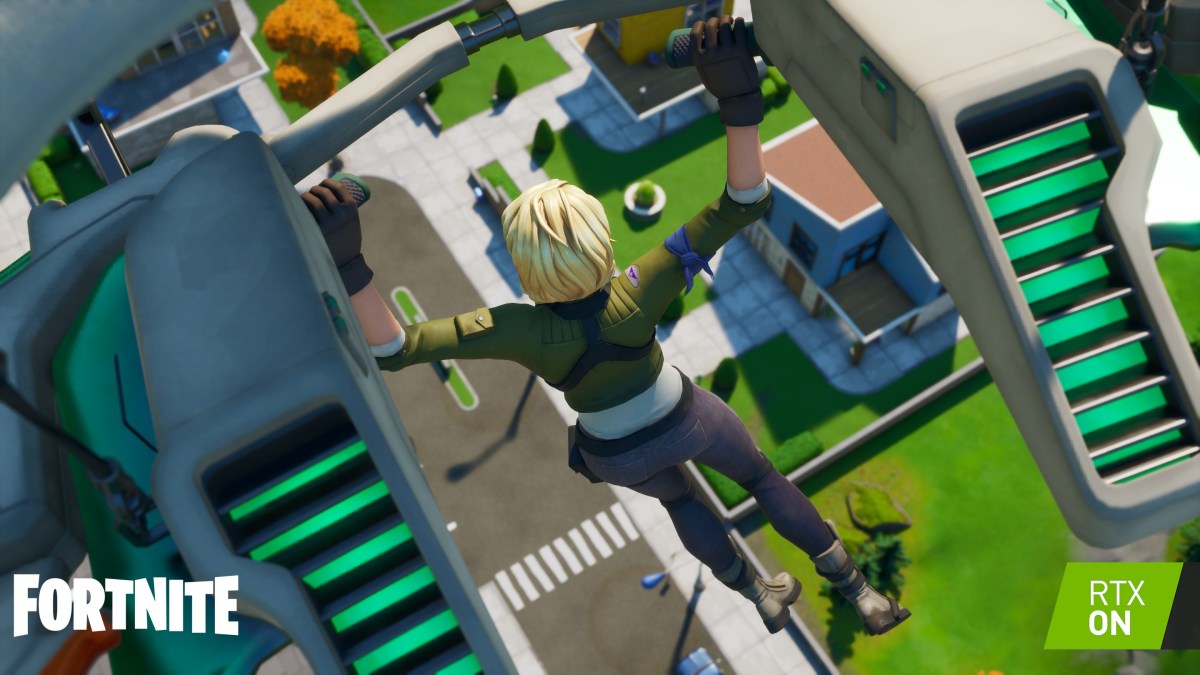Fortnite: Why NVIDIA Reflex Is Perfect for No Build Mode
Adventures in Fortnite with NVIDIA’s brilliant Reflex low-latency technology.

This article is presented by NVIDIA.
After nervously entering the world of Fortnite for the first time to test NVIDIA’s superb Reflex technology a few weeks ago, I think I now see why it’s become an international megahit.
Granted, anything that gives me an excuse to get more use out of the top-of-the-range MSI GS66 Stealth laptop NVIDIA sent for testing is very welcome indeed. With the company’s RTX 3080 mobile GPU at the heart of things, Fortnite zips along at an astonishing ~160fps at 2K resolution with detail up high. As well as the raw power, that’s likely also thanks to the clever DLSS upscaling technology that uses AI to give you both high framerates and high fidelity graphics.
Even enabling the famously intensive graphical niceties of ray tracing — where every beam of light is accurately modelled by NVIDIA RTX GPUs for incredible reflections, shadow, and lighting — leaves the game running at a buttery ~60fps. Given much of Fortnite is spent traversing the massive Battle Royale Island evading the coming storm while spotting enemy silhouettes in the distance, ray traced visuals certainly gave me something to gawp at, and I spent way longer than I should in a speed boat, marvelling at the way the sun reflected on the waters.
Best of all, given the average Fortnite player is roughly half my age with the kind of natural youthful reflexes that have eroded in me over the last 15 year, I can’t help but feel the fact that I’m still competitive is more than a little down to a helping hand from NVIDIA’s new Reflex technology. And with the new No Build mode drawing in fresh faces and returning veterans alike, any competitive advantage is certainly worth grabbing with both hands.
The NVIDIA Reflex Advantage
To recap, Reflex is NVIDIA’s way of tackling latency. Not the latency you get when playing online games — or ping, as it is known among gamers — but local latency. That is to say the amount of time it takes for your actions (a mouse click, pressing space, etc.) to register on screen (a bullet leaving your gun, your character jumping).
Reflex is something that has to be coded into the game, but is already in eight of the 10 most popular competitive shooters, says Seth Schneider, Senior Product Manager at NVIDIA.
“I’d say ‘worst case Reflex integration’ is like a 20 to 25% reduction in latency,” Schneider tells Den of Geek. “Really, really good ones that we see are even above 50%, they’ll be 60 to even 65% latency reduction, which is phenomenal.”
The benefits of Reflex in a fast-paced game like Fortnite should be immediately obvious: with faster reactions, you’re quicker on the draw, more responsive with your aim, and able to lay down shots a bit faster than your opponents. Unless they’re also using NVIDIA Reflex, of course, in which case you’ll have to rely on your natural gaming talents.
My favorite Reflex-aided kill in Fortnite came really early on in a round, when I stumbled across two people fighting in a building. I ducked in, and with Reflex helping me respond quickly, was able to take down my opponent before they could even turn around and take aim. But with another player rattling around on the floor above, there was no time to lose: I grabbed my dead teammate’s discarded shotgun and closed myself in a room, lying in wait. Sure enough, the other player opened the door, and I was able to instantly respond with a one-shot shotgun blast before they knew what hit them.
My experience playing Fortnite has been full of fine-margin wins like that, and I find myself silently saluting the technology helping me live to fight another day. Like when you’ve got someone in your sights with the sniper rifle and they’re making your life extra difficult by jumping around like no soldier ever has in real life. Timing is everything, and with Reflex, I’m pleased to say that I’ve pulled off more than my fair share of unlikely headshots. This may have left them under the false impression that I’m some kind of elite hacker rather than just a below-average gamer with magical hardware at his fingertips.
Although I spoke to him before my Fortnite journey began, Schneider would likely be unsurprised by these coin-toss moments that in Fortnite are a matter of life and death.
“Let’s say you’re running an RTX 3050 at 1440p,” he says. “Generally in Fortnite, that’s going to be somewhere between 60 to 80fps at decent, pretty high settings. So at that, without Reflex you would expect latency of around 60 milliseconds.”
That, he says, is something you can certainly feel. “It feels a little squishy, a little floppy.” With Reflex minimizing the render queue and optimizing the CPU side, it’ll “reduce us down to 30 and maybe even 25 milliseconds,” he explains.
“For competitive gamers, that’s obviously the pull, but honestly it helps pretty much any game that requires responsiveness. Whether you’re grinding a Soulslike or playing a platformer… latency’s important for everything.”
The only real problem with NVIDIA Reflex is that I may have spoiled myself for other gaming platforms that don’t offer the same advantages. “Just this weekend I was playing my console on the TV with my son,” Schneider says. “We just got the new Lego Star Wars game, and it was fun, but it runs at 30fps on a TV and the latency was so bad! I have ruined myself on TV console gaming.”
